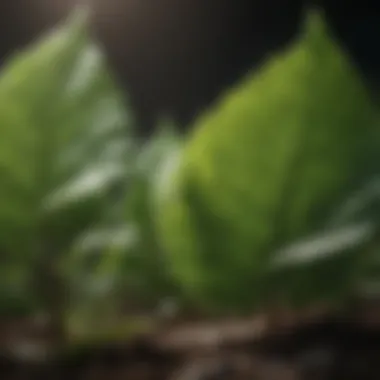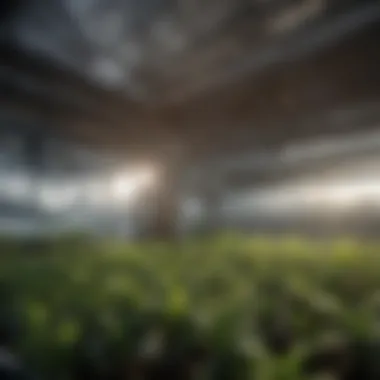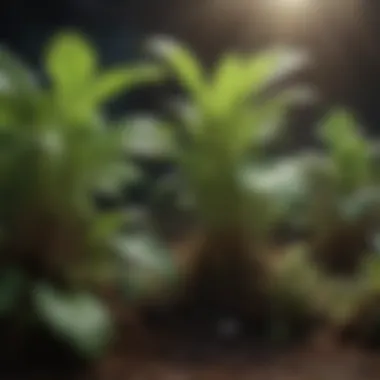Understanding Low Humidity's Impact on Plant Growth


Overview of the Topic
Definition and Importance
Low humidity in grow tents is characterized by moisture levels that fall below the recommended range for optimal plant growth. Humidity refers to the amount of water vapor in the air, and it is crucial for various physiological processes in plants, including transpiration and nutrient uptake. When humidity is too low, plants can suffer, leading to stunted growth, leaf curling, or even plant death. Understanding the dynamics of low humidity is essential for growers who seek to maximize their yields and maintain healthy plants.
Current Trends
Grow tents are becoming increasingly popular among both amateur and professional gardeners. As more people turn to indoor gardening, the need for knowledge about humidity control grows. There is a rising demand for products that regulate humidity effectively, including humidifiers and hygrometers. Growers are also collaborating on online platforms, including Facebook and Reddit, to share best practices and experiences regarding humidity management in grow tents. This knowledge sharing has helped many growers find solutions tailored to their specific needs.
Key Techniques and Practices
Step-by-Step Guide
- Assess the Current Humidity Levels
Use a hygrometer to measure the humidity. This tool will give you a clear picture of your grow tent's moisture levels. - Determine the Optimal Range
Most plants thrive in humidity levels between 40-70%. Know the preferred humidity for your specific plants. - Adjust Humidity Accordingly
If humidity is low, consider using a humidifier or placing shallow trays of water inside the tent. - Monitor Regularly
Keep checking humidity levels to ensure they remain stable. Adjust your equipment as needed.
Tools and Equipment Needed
- Hygrometer
- Humidifier
- Water trays
- Fans (for circulation)
These tools can help maintain the right humidity levels and support healthy plant growth.
Challenges and Solutions
Common Obstacles
One major challenge of low humidity is the rapid loss of moisture, especially during warmer months. Also, if the grow tent is located in a dry area, maintaining humidity can become difficult. Another issue can arise when using heating systems, which often reduce humidity.
Innovative Solutions
- Implement Regular Watering Schedule
Frequent watering can increase humidity but be cautious of overwatering. - Use Damp Sponges or Towels
Placing these inside the tent can help raise humidity levels. - Automation
Consider investing in automated systems that can monitor and adjust humidity levels dynamically.
Understanding and managing low humidity is crucial for successful plant cultivation in grow tents. Failing to address moisture levels can lead to irreversible damage.
With a thoughtful approach, growers can navigate the complexities of humidity control effectively and ensure their plants thrive.
Intro to Humidity in Grow Tents
Humidity is a crucial factor in the controlled environments of grow tents. Understanding its role can greatly improve plant health and yield. Low humidity often leads to stress in plants, impacting their growth and development. Growers need to monitor humidity levels consistently to create optimal conditions.
Understanding humidity requires defining what it signifies in relation to plant growth. When humidity levels drop too low, plants can suffer from dehydration, which affects their ability to photosynthesize and absorb nutrients effectively.
Defining Humidity in the Context of Plant Growth
Humidity refers to the amount of water vapor in the air. It is measured in percentage. A higher percentage indicates more moisture. In the context of plant growth, humidity influences various physiological processes. For example, it affects transpiration, which is the movement of water from plant roots through stems to leaves. This process is vital for nutrient transport and regulating plant temperature.
Plants have optimal humidity ranges for healthy development, often around 40-60%. Variations outside this range can lead to significant challenges, particularly for sensitive species. Understanding these optimal levels helps in managing grow tent environments more effectively.
Importance of Humidity Regulation
Regulating humidity is key to maintaining plant health. When humidity is too low, plants may exhibit signs of stress. They could develop leaf curl or other physiological issues. In extreme cases, flowering and fruiting may be inhibited, leading to reduced yields.
Moreover, low humidity can promote pest infestations and diseases. These factors not only hinder plant growth but also complicate cultivation efforts. Therefore, growers must prioritize humidity management as a fundamental aspect of their growing strategy.
Proper humidity regulation enhances plant growth, minimizes stress, and prevents disease, which ultimately leads to better yields.


In essence, understanding and controlling humidity is not just about maintaining a comfortable environment but creating favorable conditions for plant development.
Understanding Low Humidity
Understanding low humidity is crucial for anyone working with grow tents. This concept holds significance because the establishment of proper moisture levels directly influences plant growth and development. Low humidity can lead to adverse effects on the health of plants, causing issues like stunted growth and leaf desiccation. Therefore, comprehending the elements of low humidity helps growers devise strategies to mitigate its negative impacts.
What Constitutes Low Humidity?
Low humidity is typically characterized by a relative humidity level below 40%. In a grow tent, this can manifest as dry air that does not hold enough moisture to meet the needs of growing plants. Many plants thrive in environments where humidity is maintained between 40% to 60%. When humidity dips below this threshold, it can create stress on the plants, hindering their growth and even leading to various health issues.
Causes of Low Humidity in Grow Tents
Low humidity in grow tents can arise from multiple sources, each playing a role in the overall climate of the tent. Understanding these causes is essential as they provide insight into how to correct low moisture levels.
Temperature Control
Temperature control is a vital factor affecting humidity levels. When temperatures rise, the air can hold more moisture, but this can also lead to rapid evaporation of water from plants and the growing medium. This increases the likelihood of low humidity occurring. Most growers aim to maintain a balanced temperature. However, in excessively hot conditions, they may struggle to replenish moisture adequately. Thus, maintaining an appropriate temperature can directly correlate with humidity levels, potentially offering a beneficial environment for plant health.
Ventilation Issues
Ventilation issues are significant contributors to low humidity situations. If airflow is too excessive, it can lead to the loss of moisture more rapidly than the existing water sources can replenish it. Proper ventilation is necessary for plant health, but an unbalanced system can skew moisture retention. A well-calibrated ventilation setup facilitates air exchange without compromising humidity levels, making it an essential consideration for achieving optimal conditions.
Watering Practices
Watering practices also link closely to humidity levels in grow tents. Under-watering can result in decreased moisture availability in the air, exacerbating dry conditions. Conversely, over-watering without adequate drainage can generate unwanted humidity leading to mold and rot. A consistent watering regimen that aligns with plant requirements is essential. Each grower may find various techniques more useful depending on their specific environmental circumstances. Managing the balance of these practices can help maintain desired humidity levels.
"Understanding and adjusting the causes of low humidity can significantly improve plant health and yield."
Impacts of Low Humidity on Plant Growth
Low humidity in grow tents has significant implications for plant development, affecting various aspects of healthy growth. When humidity levels drop below optimal ranges, it can lead to physiological stress and decreased vitality in plants. This section delves into the consequences of low humidity and elaborates on its effects across different plant species, as well as the physiological responses triggered by such conditions.
Effects on Different Plant Species
C3 vs. C4 Plants
C3 and C4 plants have distinct ways of processing carbon in photosynthesis, which influences how they respond to low humidity. C3 plants, such as wheat and rice, generally thrive in cooler, wetter environments. Their photosynthesis process is more efficient at lower temperatures but less effective under high light and stress conditions caused by low humidity.
Conversely, C4 plants like maize and sugarcane have evolved to utilize water more efficiently. They possess a unique biochemical pathway that allows them to minimize water loss during photosynthesis. In conditions of low humidity, C4 plants often show better resilience. This adaptation is advantageous in environments where humidity can fluctuate significantly, making C4 plants a beneficial choice for growers in arid regions with low humidity.
Tropical versus Temperate Crops
The origin of a plant species significantly impacts its adaptability to humidity levels. Tropical crops, such as bananas and orchids, generally prefer high humidity due to their evolutionary adaptation to rainforests. In low humidity environments, these plants can experience wilting and stress, ultimately affecting yield and quality. Their sensitivity to low humidity makes careful monitoring crucial for successful cultivation.
On the other hand, temperate crops like carrots and cabbages are often more adaptable to varying humidity levels. However, prolonged exposure to low humidity can still hinder their growth, leading to stunted development. By understanding the unique needs of these crop types, growers can tailor their humidity management strategies.
Physiological Responses to Low Humidity
Transpiration Effects
Transpiration is the process by which plants release water vapor into the atmosphere. Low humidity levels increase the rate of transpiration due to a greater vapor pressure difference between the inside of the leaf and the surrounding air. This escalated water loss can lead to dehydration, which may inhibit nutrient uptake and result in wilting.
In environments where low humidity is prevalent, efficient irrigation becomes essential. Proper management ensures plants can replace lost moisture. Recognizing the signs of excessive transpiration helps growers act quickly to amend their cultivation practices.
Stomatal Closure


Stomata are tiny openings on the leaf surface that regulate gas exchange. When humidity drops, plants often respond by closing their stomata to reduce water loss. However, this action restricts the intake of carbon dioxide, essential for photosynthesis. The result is often reduced growth and health in plants.
Understanding the threshold at which stomatal closure occurs is crucial for growers. By adjusting environmental factors to maintain adequate humidity, growers can mitigate the adverse effects associated with stomatal closure and promote robust plant growth.
Effective humidity management is essential for developing resilient crops that can thrive in varied conditions.
In summary, understanding the impacts of low humidity on plant growth allows farmers and enthusiasts to make informed decisions. By recognizing how different species react to low humidity, as well as the physiological adjustments they undergo, it is possible to create suitable environments for flourishing crops.
Detection of Low Humidity Levels
Detecting low humidity levels in grow tents is essential for effective plant growth management. An environment with low humidity can lead to serious complications for plants, including stunted growth and even death. Thus, recognizing early signs of low humidity allows growers to take corrective measures promptly, ensuring that plants receive the optimal conditions for flourishing. This section will discuss two primary methods of detection: utilizing humidity sensors and observing visual signs. Each method serves as an important tool for maintaining the overall health of plants.
Utilizing Humidity Sensors
Humidity sensors are critical tools in managing and monitoring the moisture levels within grow tents. These devices provide precise readings of humidity levels, allowing growers to respond to changes effectively. Sensors can be digital or analog, with digital sensors often offering more features such as data logging or connectivity to smartphone applications.
The key benefit of using humidity sensors is their accuracy. Unlike visual observations, these sensors give real-time data. This real-time feedback enables growers to make informed decisions about watering practices, ventilation, and other environmental controls.
The unique feature of employing sensors includes alarms that trigger when humidity drops below a preset threshold. This reaction allows growers to act before the plants suffer any detrimental effects. However, some growers may find the initial investment for high-quality sensors to be a disadvantage. Still, the long-term gains often outweigh these costs, making humidity sensors a wise choice for effective management.
Visual Signs of Low Humidity
Sometimes, despite the technology available, growers need to rely on visual indicators of low humidity. These cues can signal underlying problems that require immediate attention. Observing your plants carefully can provide insights that documentation alone might not convey.
Leaf Curling
A significant symptom of low humidity is leaf curling. This phenomenon occurs when plants attempt to conserve moisture by reducing the surface area exposed to the air. Curling leaves often turn inward or upwards, signaling that the plants are stressed due to their environment.
This characteristic makes leaf curling a popular choice for quick diagnosis because it is easily visible. Observing this sign allows growers to take actions, like increasing humidity levels, before permanent damage occurs.
However, excessive leaf curling could also indicate other issues, such as nutrient deficiencies or pest infestations. In this case, it can be both an advantage as an initial indicator and a disadvantage as it may lead growers to misdiagnose plant health issues.
Brown Tips on Leaves
Another visual sign of low humidity is the presence of brown tips on leaves. As moisture evaporates quickly from the foliage, the leaf edges often turn brown and crispy, indicating that the plant is dehydrated. This characteristic is prevalent among various plant species.
Brown tips serve as a beneficial clue to diagnosing low humidity; they are often the first outward signs of stress. Just like curling leaves, noticing this change can prompt immediate action to adjust the humidity levels.
Nonetheless, it is important to keep in mind that brown tips can also indicate over-fertilization, therefore, relying solely on this sign for diagnosis could be misleading.
Maintaining awareness of these visual cues alongside using humidity sensors creates a balanced monitoring system that enhances plant growth and health.
Strategies for Managing Humidity
Managing humidity levels in grow tents is vital for ensuring plant health. Low humidity can lead to various issues such as stunted growth and increased susceptibility to pests. This section outlines strategies that growers can employ to manage humidity effectively. Understanding these strategies benefits both novice and experienced growers alike, as it provides practical solutions needed to cultivate plants in optimal conditions.
Methods for Increasing Humidity
Using Humidifiers
Humidifiers are a widely used approach to increase humidity levels in grow tents. These devices introduce moisture into the air, which is essential for plants, especially in low humidity conditions. A key characteristic of humidifiers is their ability to maintain consistent humidity levels. This consistency can lead to healthier plants that grow robustly and efficiently.
One unique feature of humidifiers is their adjustable settings, allowing growers to customize the humidity level according to the specific requirements of the plants they are cultivating. However, there are some disadvantages to consider. For instance, if not monitored properly, humidifiers can lead to excessive moisture and promote mold growth, which can damage plants. Overall, humidifiers are a beneficial choice for maintaining humidity, provided they are used with caution and regular maintenance.
Water Trays and Misting


Another effective method for increasing humidity is the use of water trays and misting. This technique involves placing shallow trays of water within the grow tent or periodically misting the plants with water. The importance of this method lies in its simplicity and low cost.
Water trays and misting create an immediate boost in humidity around the plants. A key characteristic of this method is its low energy consumption compared to electric humidifiers. Also, it can help in cooling the ambient temperature, benefitting the plants. However, a notable disadvantage is that it may require more frequent attention. Water trays need to be refilled regularly, and misting can be time-consuming. Despite this, the benefits of using water trays and misting make them popular options for increasing humidity, especially in small-scale operations.
Creating a Controlled Environment
Sealing Grow Tents
Sealing grow tents is a crucial practice for maintaining humidity levels. Proper sealing prevents outside air from entering, which can often be dryer than the controlled environment inside the tent. This action protects the internal conditions necessary for plant growth. A major benefit of sealing grow tents is the reduction in fluctuations in both temperature and humidity, creating a more stable environment for plants.
This method not only secures humidity but also enhances energy efficiency. However, over-sealing can lead to poor air circulation, which is essential for plant health. Therefore, balancing sealing with ventilation is necessary.
Adjusting Air Circulation
Adjusting air circulation is another important strategy in creating a controlled environment. Proper air circulation helps distribute humidity evenly throughout the grow tent. A key characteristic of good air circulation is that it prevents hot spots and moisture buildup in specific areas, thereby reducing the risk of mold and mildew.
Moreover, circulatory fans can also help strengthen plant stems, making them more resilient. However, excessive air movement can dry out the plants, countering the very goal of humidity management. Hence, maintaining a gentle airflow is essential.
Good air circulation, alongside proper humidity management, directly impacts the overall health and growth of plants.
These strategies form the backbone of effective humidity control in grow tents, contributing to healthier and more productive plants.
Long-term Planning for Humidity Control
Long-term planning for humidity control is crucial for growers. It allows for proactive measures instead of reactive ones. By understanding the environment in which plants thrive, growers can create stable conditions that support healthy growth year-round. Consistent humidity levels promote robust plant health and reduce the likelihood of moisture-related diseases. In addition, planning ensures that changes in humidity do not negatively impact the plants, which can lead to losses.
Standard Operating Procedures
Establishing standard operating procedures is essential for maintaining humidity levels. This includes regular monitoring of humidity and temperature, ensuring that necessary equipment is in working condition, and implementing maintenance schedules. Procedures can involve the use of data loggers or humidity sensors, allowing for accurate readings over time. Also, growers should document their findings and adjust strategies based on those results. Being consistent with these practices ensures that growers can respond promptly to changes in the environment.
Seasonal Considerations
Understanding seasonal changes is vital. Different seasons present unique challenges and opportunities for humidity management. Each season can affect plant growth in specific ways, necessitating tailored responses.
Summer Challenges
In summer, high temperatures often lead to decreased relative humidity. Plants can suffer from stress as they lose moisture rapidly through transpiration. This can cause wilting and hinder growth. Thus, managing heat becomes a priority. Growers must be aware that ventilations systems might need adjustments to maximize airflow while maintaining humidity levels. For instance, implementing misting systems can help increase humidity temporarily. However, its unique feature is the short-term solution it provides. It may not suffice alone for long-term control, but it can be beneficial when combined with other methods.
Winter Adjustments
Winter presents its challenges as well. The air indoors typically gets drier due to heating. Humidity can drop significantly, and plants may struggle to adapt. This requires somewhat of a counteractive approach compared to summer. Using humidifiers or placing water trays near heat sources helps to add moisture to the air, ensuring plants receive adequate humidity. The key characteristic of winter adjustments lies in its need for controlled increase of humidity over extended periods.
Always monitor humidity with sensors and adjust practices based on seasonal changes.
Ending
The conclusion serves as a vital summary of the insights presented in this article about low humidity in grow tents. It emphasizes the need for growers to recognize the critical role of humidity in plant development. When we underline the significance of humidity management, it becomes clear that optimal levels are not merely an option but a necessity for ensuring healthy plant growth. This acknowledgment can prevent many issues related to stunted growth and poor health of plants.
Recap of Key Points
To consolidate understanding, let's revisit the essential points discussed:
- Defining Low Humidity: Low humidity is a relative term that can greatly influence plant physiology. It is crucial to establish a benchmark for what constitutes low humidity in your specific growing environment.
- Causes and Consequences: Identifying the reasons for low humidity—such as improper temperature control and ventilation issues—is key. Furthermore, understanding how these factors impact different plant types can guide appropriate action.
- Detection: Utilizing tools like humidity sensors allows for proactive monitoring. Also, recognizing visual signs of distress in plants can serve as an early warning system.
- Management Strategies: Methods for increasing humidity are varied—from using humidifiers to adjusting air circulation methods within tents. Each method has its pros and cons, requiring careful consideration tailored to the specific grower's needs.
- Long-term Considerations: Seasonal changes come with their own challenges, necessitating a seasonal approach to humidity management. This planning helps in adapting strategies accordingly.
The Future of Humidity Management in Grow Tents
As we look ahead, it is evident that technology will play an increasingly pivotal role in humidity management. Advanced monitoring systems are emerging, offering precision control over environmental factors within grow tents. These systems can adjust humidity levels automatically, responding to real-time data about environmental changes.
Moreover, there is likely to be a rise in integrating smart devices within agricultural practices. This includes smartphone applications that would allow growers to monitor conditions from anywhere, providing flexibility and improved management. The evolution of humidity management tools will help growers respond swiftly to changes, ensuring that the plants remain in a conducive environment.
Finally, ongoing research into plant responses to varied humidity levels will offer new insights. As we increase knowledge base on best practices, farmers and enthusiasts can make better-informed decisions to promote robust plant health.



